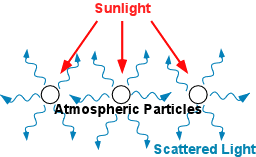What is scattering of light?
1 Answer
Scattering involves light being absorbed by irregularities or particles within/on a medium, then being emitted at a slightly different energy/wavelength.
Explanation:

Before we start, we need to recognize that light can be a wave or a particle and that light interacts with atoms by photons being absorbed and emitted. This can get quite complex, but at a simple level, atoms can absorb certain photons (particles of light) if they have the right amount of energy. This energy then moves an electron up an energy level.
Light scattering is what it sounds like - rays of light get scattered (or deflected in different directions). However, different wavelengths of light will be scattered more or less depending on the medium they are travelling through or material they are hitting.
Small (very very small! We are talking atomic level here) irregularities on an object's surface or particles within a medium can scatter certain wavelengths of light so that it appears to be a certain color.
This is because the particles of light (photons) are absorbed - scattering is a form of particle interaction - and then emitted at a different energy/wavelength (although there is a form of scattering where no energy is lost).
So the next time someone answers a question they don't know the answer to with "why is the sky blue?", you can reply with "well, because the molecules in air have scattered blue light more than any other type so we see those waves the most!"
So what is the difference between scattering and just normal reflection?
Scattering occurs when a particle of light is fully absorbed and then emitted while reflection is when a wave/particle is simply reflected off the surface without interacting.
Reflection
 )
)
Scattering
 )
)
Now, this is quite a complicated topic to understand, especially as it brushes on the realms of quantum physics, so feel free to contact me through my profile if you need anything clearing up:)
Hope this helps!
